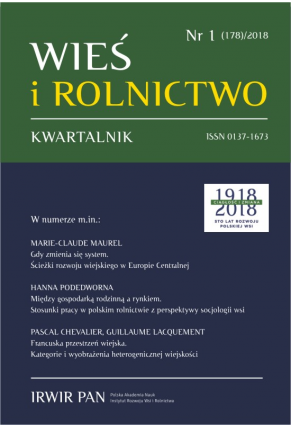Formal Education in the Context of Demografic Changes in Rural Areas
DOI:
https://doi.org/10.53098/wir012018/07Keywords:
education, training, demography and education, changes in the educational system in PolandAbstract
The aim of the article is to highlight how demographic changes in Poland and projections for the coming years can affect the operation of and the need for changes in formal education establishments run by gminas (municipalities), especially rural ones. Trends concerning changes in population growth, especially in terms of birthrate and rate of natural increase, affect the emerging baby booms and busts in different age groups of children and youth attending schools at each grade. It is important that all grades of education take into account the changing age structure of the population, the need for teachers to make their students aware of the need for lifelong learning because of changes in future labor resources, and to provide quality education in response to labor market challenges. Demographic changes also affect the structure of expenditures earmarked by a gmina for education. The funds available to most gminas from education subsidies do not cover the costs of educational establishment operation. If the number of pupils falls, the amount of the educational subsidy decreases, the costs of running a school remaining at a constant level, which exacerbates its financial standing. The role of gmina authorities is to take into account demographic challenges in managing the network of schools and other educational establishments. This involves consolidation activities. Institutions running educational establishments should also take into account other social risks resulting from population projections, such as the aging process, including aging of the teachers’ group and a declining number of youth pursuing studies at tertiary education establishments.
References
Babczuk A., Talicz A. (2015). Dotacje oświatowe Problemy i wyzwania Poradnik dla jednostek samorządu terytorialnego. Warszawa: Ośrodek Rozwoju Edukacji.
Dziemianowicz-Bąk A., Bochno I., Materek A., Kajtowska-Ślęzak A., Urmański J., Gajdała A., Pająk K. (2012). Gminy wobec wyzwań oświatowych. Przykłady strategicznych działań samorządów w zakresie edukacji. Analizy IBE/05/2012, Warszawa: Instytut Badań Edukacyjnych.
Federowicz M. (2010). Społeczeństwo w drodze do wiedzy. Raport o stanie edukacji 2010. Warszawa: Instytut Badań Edukacyjnych.
Gabryelak E. (2016). Fundusze Unii Europejskiej jako instrument poprawy sytuacji edukacyjnej dzieci i młodzieży z terenów wiejskich województwa łódzkiego. Praca doktorska. Łódź: Wydział Ekonomiczno-Socjologiczny, Uniwersytet Łódzki.
GUS (2009). Prognoza Demograficzna z 2008 roku. Warszawa: Główny Urząd Statystyczny.
GUS (2014). Prognoza ludności na lata 2014–2050. Warszawa: Główny Urząd Statystyczny.
GUS (2017a). Ludność i ruch naturalny 2016. Warszawa: Główny Urząd Statystyczny. http://stat.gov.pl/obszary-tematyczne/ludnosc/ludnosc/ludnosc-i-ruch-naturalny-w-2016-r-,30,1.html.
GUS (2017b). Oświata i Wychowanie 2016/2017. Warszawa: Główny Urząd Statystyczny.
Herbst M. (2012). Finansowanie oświaty. Warszawa: Wydawnictwo ICM, Uniwersytet Warszawski.
Herczyński J. (2012). Wskaźniki oświatowe. Warszawa: Wydawnictwo ICM, Uniwersytet Warszawski.
Levitas A. (2012a). Innowacyjne przykłady zarządzania i finansowania oświaty przez samorządy. Baza dobrych praktyk. Warszawa: Ośrodek Rozwoju Edukacji.
Levitas A. (2012b). Strategie oświatowe. Warszawa: Wydawnictwo ICM, Uniwersytet Warszawski.
Schlotter M.G., Schwerdt G., Wössmann L. (2008). The Future of European Education and Training Systems: Key Challenges and Their Implications. European Expert Network on Economics of Education (EENEE), EENEE Analytical Report No. 3, Prepared for the European Commission.
Sprawozdanie… (2015). Sprawozdanie z Wykonania Budżetu Państwa za okres od 1 Stycznia do 31 Grudnia 2014 r. Informacja o Wykonaniu Budżetów Jednostek Samorządu Terytorialnego.
Sprawozdanie… (2016). Sprawozdanie z Wykonania Budżetu Państwa za okres od 1 Stycznia do 31 Grudnia 2015 r. Informacja o Wykonaniu Budżetów Jednostek Samorządu Terytorialnego.
Sprawozdanie… (2017). Sprawozdanie z Wykonania Budżetu Państwa za okres od 1 Stycznia do 31 Grudnia 2016 r. Informacja o Wykonaniu Budżetów Jednostek Samorządu Terytorialnego.
The 2012 Ageing Report. Economic and budgetary projections for the 27 EU Member States (2010–2060). (2012). European Commission, Directorate-General for Economic and Financial Affairs.
Ustawa… (1990). Ustawa o samorządzie gminnym z późniejszymi zmianami. Dz.U. 1990 nr 16 poz. 95.
Ustawa… (1991). Ustawa o systemie oświaty (z późniejszymi zmianami). Dz.U. 1991 nr 95 poz. 425.
Ustawa… (2016). Ustawa z dn. 14 grudnia 2016 Prawo oświatowe. Dz.U. 2017 poz. 59.
Van de Kaa D.J. (2002). The Idea of a Second Demographic Transition in Industrialized Countries. Paper presented at the 6th Welfare Policy Seminar of the National Institute of Population and Social Security, Tokyo, Japan, 29 January 2002.
W Polsce zaczyna się baby boom (2017). Gazeta Wyborcza, 25.01. http://wyborcza.pl/7,-87647,21292010,w-polsce-zaczyna-sie-baby-boom.html [dostęp: 30.08.2017].
Downloads
Article file downloads
Pages
How to Cite
Issue
Section
License
Copyright (c) 2018 Village and Agriculture

This work is licensed under a Creative Commons Attribution 4.0 International License.










